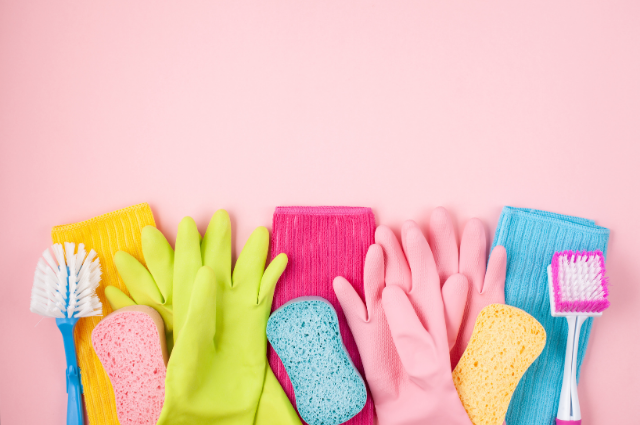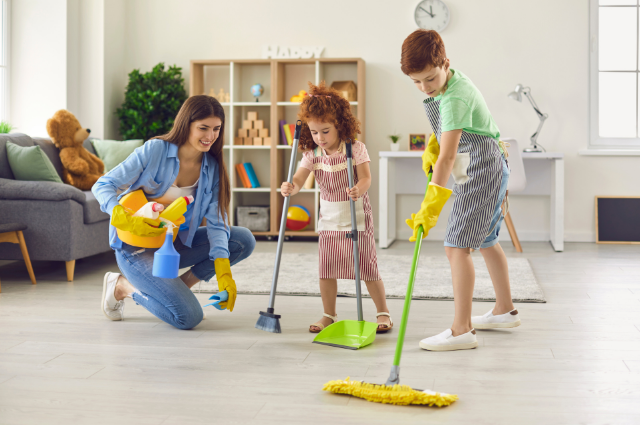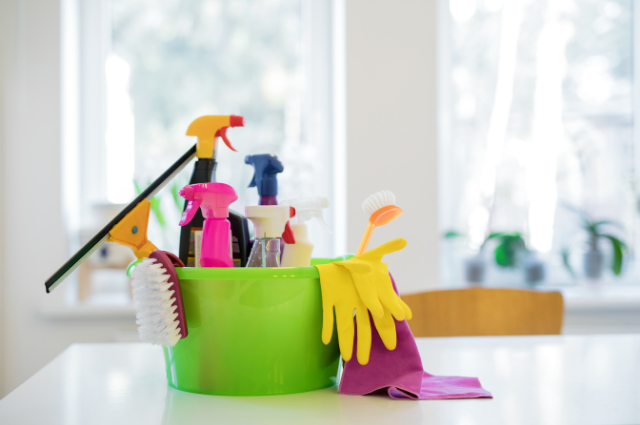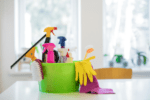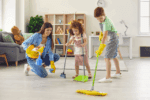This post may contains affiliate links. As an Amazon Associate, I earn from qualifying purchases. If you purchase through these links, I may earn a small commission at no extra cost to you. Read the full disclosure.
Do you ever look around your home, feel completely stuck, and wonder if you’ll ever get a handle on the mess? You’re not alone. Many people struggle with ADHD cleaning tips that truly make a difference, especially when the chaos feels all-consuming.
Fortunately, there are targeted strategies that honor the ADHD brain’s need for structure, stimulation, and flexibility.
Here are 15 detailed, down-to-earth approaches to help you transform your space into a functional haven—one step at a time.
1. Reframe Your Definition of “Clean”
When you tell yourself a home needs to be spotless, it can trigger overwhelm and procrastination. Instead, look at your surroundings from a functional point of view. Ask yourself, “Can I comfortably move around?
Can I prep a quick meal without washing a mountain of dishes first? Do I have a clutter-free spot on the couch to sit?” If the answer to these questions is “yes,” then your home is in decent shape for your needs.
It’s not about shiny floors or perfectly aligned décor; it’s about feeling at ease in your space.
Let Go of All-or-Nothing Thinking
ADHD brains often swing between “everything must be immaculate” or “why bother cleaning at all?” Finding a middle ground is essential. Sure, you might not have a magazine-ready living room 24/7, but that’s okay.
There’s a big difference between a little untidiness and a space that’s truly unlivable. Shifting your cleaning goal to “good enough” can dramatically reduce stress and create a realistic baseline you can maintain over time.
2. Adopt the “Five Things” Method
Often recommended by therapist KC Davis, this method identifies five categories to tackle when cleaning a room: trash, dishes, laundry, items with a designated place, and items without a designated place.
By labeling each piece of clutter, you reduce the mental load. You no longer see a confusing blur of random objects; you see smaller groups you can handle one at a time.
Stick to the Same Order
One key is consistency—do trash first, then dishes, then laundry, etc. This approach creates a reliable pattern that your brain can follow without much extra thought.
You’ll be amazed at how focusing on these categories alone can quickly shrink a mountain of mess. And if you get sidetracked (which happens!), simply return to whichever category you last worked on.
3. Stay in One Room Until You’re Done
It’s all too easy to wander off: you pick up a dish in the living room, carry it to the kitchen, and suddenly find yourself rearranging the pantry. Meanwhile, the living room remains half-finished. Sound familiar?
To avoid that rabbit hole, place anything that belongs in another room in a temporary bin or a small pile by the door. Once you’re done in your current space, you can deal with the items that need to be relocated.
Simplify Your Line of Sight
Keeping your attention anchored in one physical location helps reduce the sense of overwhelm. You’ll see immediate progress in that specific area, which can give you a confidence boost. The more you feel that forward momentum, the less likely you are to abandon your cleaning session early.
4. Use Timers for Short Bursts
One of the most common ADHD hurdles is the distortion of time—ten minutes can feel like two, or two minutes can feel like an hour.
By setting a simple timer (on your phone or a kitchen device) for 10 or 15 minutes, you create a tangible window for getting things done.
This technique can be incredibly motivating, turning cleaning into a fun mini-challenge rather than a marathon.
Make It a Game
Challenge yourself: “I’ll see how much I can pick up in 10 minutes.” It’s a playful, low-pressure approach that can yield serious results. If your timer goes off and you’re exhausted, you can call it quits without guilt.
If you’re on a roll, set another timer and keep going. Either way, you’re taking practical steps that your ADHD brain will appreciate.
5. Keep Your Shoes On
Sometimes, you feel a surge of energy out of nowhere—like you could tackle every household chore in a single afternoon. When that wave hits, having your shoes on helps you jump into action without hesitation.
It’s a small trick that shifts your brain from “I’m lounging” to “I’m active.”
Trick Yourself into Staying Up
Taking your shoes off signals relaxation time, which might be great for winding down but terrible for staying focused on chores. Shoes on = you’re in “go” mode. Once you’re done cleaning, feel free to slip into fuzzy socks. Until then, keep that subtle sense of urgency rolling.
6. Create Flexible Routines
A strict, detailed cleaning schedule can backfire. Instead, pick broad themes for each day. Maybe Mondays are for laundry, Tuesdays for tidying bathrooms, and so forth.
If Tuesday rolls around and you have zero energy, you can still do a quick wipe-down in the bathroom and consider it a win. This approach gives your ADHD brain enough structure to reduce decision fatigue while still allowing wiggle room.
Closing Duties for Easy Maintenance
Nighttime can be tricky when you have ADHD because you’re either exhausted or hyperfocused on something else.
Try committing to a short “closing duties” routine—throw away any obvious trash, gather dirty dishes into the sink or dishwasher, and clear your main walkway of tripping hazards.
It usually takes only a few minutes but goes a long way toward preventing a chaotic morning.
7. Add More Stimulation to Stay Engaged
If you struggle to focus in silence, give your brain extra input. Queue up an upbeat playlist or stream your favorite show.
Some people find it helpful to call a friend on speaker while they clean. The goal is to offer your mind just enough stimulation to ward off boredom without being so entertaining that you totally forget to clean.
Reward with Snacks
Dopamine plays a big role in ADHD motivation. Rewarding yourself with a tasty treat can do wonders for keeping you on track, whether it’s a few cookies, a bowl of popcorn, or a frothy latte.
Enjoy small bites or sips in between tasks to keep the momentum going.
8. Lean on Social Accountability
Try cleaning side by side with a friend or family member, even if you’re working in different rooms.
Just knowing another person is around can provide enough external motivation for your brain to stay on task. You can chat, listen to music together, or simply enjoy each other’s company while tidying.
Virtual Cleaning Hangouts
If no one’s available in person, hop on a video call. Set a timer, share your goals for the next 15 or 30 minutes, and then show each other your progress.
Sometimes, a little bit of friendly peer pressure is the ultimate kick in the pants you need to finish up those dishes or fold that laundry pile.
Check out these helpful strategies from Real Simple if you need more ideas on social accountability and motivation.
9. Focus on High-Impact Areas First
When you’re pressed for time or energy, prioritize rooms where you spend the most time or where guests are likely to drop by—the living room or kitchen, for instance.
This approach helps you see quick results, so you feel accomplished.
Make One Big Improvement
Choose something that will transform the look or functionality of the space. Maybe you tidy the couch and fluff the pillows, or clear the entire countertop. That one noticeable change often sparks motivation to keep going in smaller corners.
10. Batch Similar Tasks Together
If you try to do dishes, then wipe counters, then fold laundry, then return to dishes, your brain will struggle to transition smoothly. Instead, gather all dishes in one place and take care of them in one go.
After that, move on to your next batch of tasks, such as collecting and sorting laundry. Minimizing transitions can make a massive difference in how ADHD cleaning tips play out in real life.
Assign Specific Days for Specific Tasks
Consider dedicating Monday to laundry, Tuesday to trash and recycling, Wednesday to dusting and vacuuming, etc.
This arrangement eases decision-making because you already know what day’s duty is next. It also reduces the odds of feeling scattered when you look around and see everything that needs to be done.
11. Streamline Access to Cleaning Supplies
Put bathroom cleaning products in the bathroom. Keep kitchen supplies under the sink. Store laundry detergent next to the washing machine.
That way, there’s no need to walk around the house collecting supplies (and getting distracted). When everything is within arm’s reach, you’re more likely to keep going once you start cleaning.
Use Cleaning Kits
Create small caddies for each area of the home. Stock them with essential tools so you can grab a kit and handle the task on the spot.
For instance, a “living room kit” might include wipes, microfiber cloths, and a lint roller. Seeing that kit ready to go can be the motivational nudge you need to tackle that dusty coffee table.
For more organizational tricks, Apartment Therapy offers additional strategies to build simple and consistent routines.
12. Use an “Other Room” Box Strategy
One common ADHD challenge is wandering off mid-task. You pick up socks that belong in the bedroom, walk them over, then notice the bedroom is messy.
Next thing you know, you’ve abandoned the original cleaning job. The solution? Keep a box labeled “Other Room” in the current space you’re cleaning. Anything that belongs elsewhere goes straight into that box.
Sort It Out Later
Once you’ve finished clearing the space in front of you, take a moment to relocate the items in your “Other Room” box. Or move on to the next area and bring the box with you.
The main idea is to prevent scatterbrained side trips, allowing you to finish what you started before tackling the next phase.
13. Shift Your Cleaning Semantics
Call It a “Reset”
Words matter. Sometimes the term “cleaning” feels loaded or burdensome. Instead, call it “resetting” your space, which implies bringing your home back to a comfortable baseline.
This small tweak can reduce emotional resistance and shame. You’re not scolding yourself for having a messy house; you’re simply resetting it to a place that helps you function better.
Set Time Limits
A “15-minute reset” is easier to handle than telling yourself to “clean for however long it takes.” The finite aspect provides a psychological endpoint, which can be a huge relief for ADHD minds.
If you find yourself still energized after 15 minutes, great—keep going. If not, you can stop guilt-free.
14. Create Visual Progress Indicators
Snapping a quick photo of your room before you start can be surprisingly motivating. When you’re done (or have done “enough”), take an after shot.
Comparing the two images offers real proof that your effort paid off. This visual marker is especially helpful on days when you feel like you got “nothing” accomplished.
Visible Checklists
Instead of keeping all your to-dos in your head, write them down or use an app. Cross them off (or tap them off) as you go.
Seeing a list of what you’ve achieved can push you to complete just one more task. It’s a simple but effective way to keep track of your progress.
15. Implement Reward Systems
The ADHD brain thrives on immediate rewards. Planning a fun activity, a favorite treat, or a relaxing break right after you finish a chunk of cleaning can act as a powerful incentive.
Simple pleasures—like scrolling through a Pinterest board or indulging in a cup of tea—will feel extra satisfying after you’ve tackled a sink full of dishes or picked up clutter off the floor.
Small Wins Deserve Small Rewards
Don’t wait until your entire house is spotless. Celebrate each load of laundry folded, each kitchen counter cleared.
A quick “Yes, I did it!” moment can foster a positive emotional association with cleaning, making it less of a dreaded chore and more of a self-care routine.
Bonus Insight: Reduce Shame and Perfectionism
While not a numbered tip, it’s worth remembering that cleaning (or not cleaning) has no moral weight. You’re not “bad” if laundry piles up or “good” if your living room looks impeccable.
For many with ADHD, shame and perfectionism become bigger obstacles than the cleaning itself.
When you recognize that having a messy space doesn’t define your worth, you’re more free to look for ADHD cleaning tips that align with your actual, day-to-day life.
Conclusion
ADHD cleaning tips work best when they’re realistic, flexible, and self-compassionate.
By breaking tasks into smaller chunks, playing up your strengths (like quick bursts of energy), and reframing cleaning as a functional reset rather than an all-or-nothing ordeal, you can create a home that feels welcoming, not overwhelming.
The trick is to keep experimenting until you find a combination of strategies that fits you perfectly. You have the power to transform your space one manageable step at a time—no shame needed and no perfection required.

